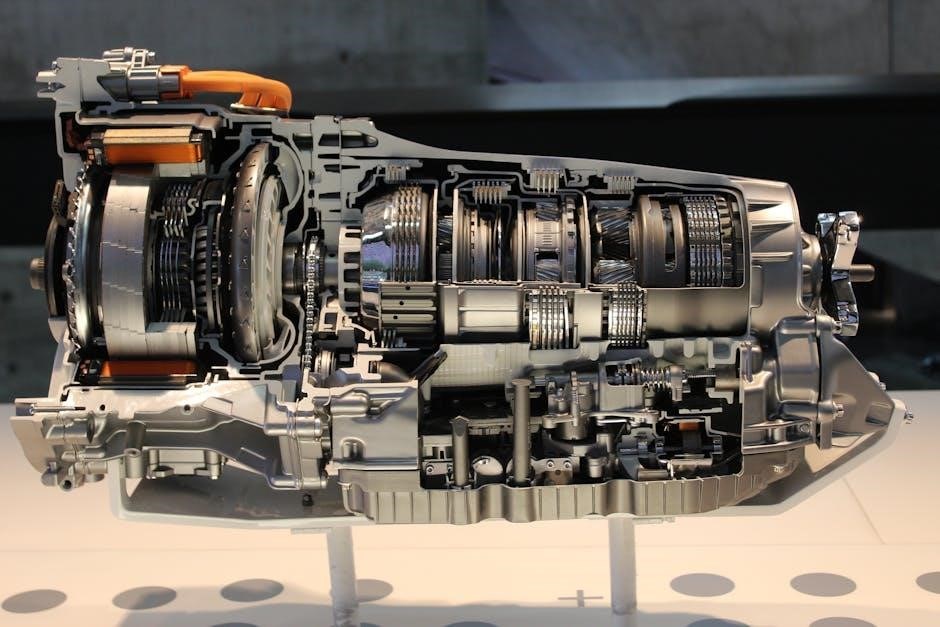The brain is a highly complex organ controlling bodily functions, interpreting sensory information, and governing intellect, emotions, and memory. Understanding its intricate structure and diverse regions is essential for appreciating its vast functional capabilities.

Major Anatomical Regions of the Brain
The brain is divided into key anatomical regions, including the cerebrum, cerebellum, and brainstem. Each region specializes in distinct functions, from higher cognitive processes to motor coordination and vital reflexes.
2.1. Cerebrum
The cerebrum is the largest and most complex part of the brain, responsible for higher cognitive functions such as thought, memory, and voluntary movement. It is divided into two hemispheres—right and left—each controlling opposite sides of the body. The cerebrum is further subdivided into four lobes: frontal, parietal, temporal, and occipital, each specializing in distinct roles. The frontal lobe manages executive functions like decision-making and planning, while the parietal lobe handles sensory input related to touch and spatial awareness. The temporal lobe is crucial for auditory processing and memory, and the occipital lobe is dedicated to vision. The cerebrum also contains the cerebral cortex, the outer layer responsible for processing sensory information and controlling movement. Beneath the cortex lies white matter, composed of nerve fibers that facilitate communication between different brain regions. This intricate organization enables the cerebrum to coordinate complex mental and physical activities, making it the center of human consciousness and intelligence.
2.1.1. Cerebral Cortex
The cerebral cortex is the outer layer of the cerebrum, responsible for processing sensory information, controlling movement, and facilitating thought, memory, and consciousness. It is divided into six distinct layers of neuronal tissue, each specialized for specific functions. The cortex is highly folded, increasing its surface area to accommodate a vast number of neurons. It is divided into sensory, motor, and association areas, with sensory regions processing input from the environment and motor areas controlling voluntary movements. Association areas are involved in complex cognitive functions, such as language, problem-solving, and decision-making. The prefrontal cortex, a subset of the frontal lobe, is particularly important for executive functions, including planning and social behavior. Damage to the cerebral cortex can result in impairments in perception, movement, or higher cognitive abilities. Its intricate structure and functional specialization make it a cornerstone of human intelligence and adaptability.
2.1.2. Lobes of the Cerebrum
The cerebrum is divided into four distinct lobes: frontal, parietal, temporal, and occipital, each responsible for unique functions. The frontal lobe is associated with executive functions, such as planning, decision-making, and problem-solving. It also plays a role in motor control and social behavior. The parietal lobe processes sensory information related to touch and spatial awareness, helping us understand our environment. The temporal lobe is crucial for auditory processing, memory, and language comprehension. Lastly, the occipital lobe is primarily responsible for visual processing, interpreting signals from the eyes. Each lobe works in coordination with the others, ensuring seamless integration of cognitive, sensory, and motor functions. Damage to specific lobes can lead to deficits in corresponding abilities, highlighting their specialized roles in overall brain function.
2.2. Cerebellum
The cerebellum, located at the back of the brain below the cerebrum, plays a crucial role in coordinating voluntary movements, maintaining posture, and regulating balance. It ensures smooth and precise muscle actions by integrating sensory information with motor responses. The cerebellum is also involved in motor learning, allowing individuals to refine and automate complex movements over time. Its structure consists of a central vermis and two hemispheres, each contributing to specific functions. Damage to the cerebellum can result in ataxia, characterized by clumsiness, loss of coordination, and difficulty with speech. Recent studies suggest the cerebellum may also have cognitive roles, though its primary function remains motor control. This small but vital structure is essential for physical agility and overall neurological harmony.
2.3. Brainstem
The brainstem, positioned between the cerebrum and the spinal cord, serves as a vital connector, facilitating communication between higher and lower brain centers. It consists of three main parts: the midbrain, pons, and medulla oblongata. The midbrain plays a role in auditory and visual processing, while the pons acts as a bridge, relaying signals between the cerebrum and cerebellum. The medulla oblongata is responsible for controlling involuntary functions such as breathing, heart rate, and blood pressure. The brainstem also regulates fundamental processes like swallowing, coughing, and sneezing. Damage to this region can lead to severe impairment or even death, highlighting its critical role in sustaining life. The brainstem ensures the proper functioning of both voluntary and involuntary bodily activities, making it an indispensable component of the central nervous system.
2.3.1. Pons
The pons is a crucial part of the brainstem, acting as a communication pathway between the cerebrum and cerebellum. It consists of bundles of nerve fibers that facilitate the transmission of signals, enabling coordination between these regions. Additionally, the pons plays a significant role in controlling sleep and arousal, influencing the onset of dreams and the transition between sleep stages. It also regulates certain autonomic functions, such as bladder control and hearing. Damage to the pons can result in severe neurological deficits, including impaired motor skills and sleep disturbances. The pons is essential for maintaining the balance between conscious and subconscious activities, ensuring smooth communication and coordination within the brain.
2.3.2. Medulla Oblongata
The medulla oblongata, the oldest part of the brain, is responsible for controlling vital involuntary functions such as breathing, heart rate, and blood pressure. It is located at the lowermost part of the brainstem and connects the pons to the spinal cord. This structure ensures that basic life-sustaining processes operate without conscious thought. For instance, the medulla regulates the autonomic nervous system, which manages functions like digestion, sneezing, and vomiting. It also serves as a relay station for nerve signals between the brain and the body. Damage to the medulla can be catastrophic, leading to respiratory failure or even death, as it is indispensable for maintaining essential bodily functions. Its role underscores its importance as the fundamental control center for survival.
2.3.3. Midbrain
The midbrain, located above the pons and below the thalamus, serves as a critical link between the brainstem and higher brain centers. It plays a pivotal role in processing auditory and visual information, facilitating communication between the cerebrum and cerebellum. The midbrain contains essential structures like the tectum and tegmentum, which handle sensory processing and motor coordination. It is also responsible for regulating body temperature, pain perception, and the body’s alertness and arousal through the reticular formation. Additionally, the midbrain controls eye movements and maintains balance and posture. Damage to this region can impair sensory processing, motor functions, and consciousness, highlighting its vital role in integrating sensory and motor activities. The midbrain’s functions are fundamental to maintaining various bodily operations and ensuring effective communication across different brain regions.

Subcortical Structures and Their Functions
Subcortical structures, located beneath the cerebral cortex, play crucial roles in regulating emotions, hormones, and sensory processing. Key structures include the thalamus, hypothalamus, limbic system, and basal ganglia, each serving unique functions.
3.1. Thalamus
The thalamus is a critical subcortical structure acting as a relay station for sensory and motor signals. It processes and directs information to the cerebral cortex, ensuring proper integration of sensory inputs. The thalamus plays a key role in regulating consciousness, sleep, and alertness. It acts as a filter, determining which sensory information reaches the cortex. Damage to the thalamus can lead to sensory deficits and cognitive impairments; Additionally, the thalamus facilitates communication between different brain regions, enhancing the brain’s overall functional connectivity. Its role in managing the flow of neural signals makes it indispensable for maintaining normal brain function and responsiveness to external stimuli.
3.2. Hypothalamus
The hypothalamus is a small but vital subcortical structure located below the thalamus, playing a central role in maintaining homeostasis. It regulates body temperature, hunger, thirst, and circadian rhythms, ensuring the body’s internal balance. The hypothalamus produces hormones that influence the pituitary gland, which in turn controls other endocrine glands. It also coordinates the autonomic nervous system, managing involuntary functions like heart rate and blood pressure. Additionally, the hypothalamus is involved in emotional responses and sexual behavior. Its ability to link the endocrine and nervous systems makes it a key player in overall bodily regulation. Dysfunction in the hypothalamus can lead to issues such as hormonal imbalances, growth disorders, and metabolic problems. Its intricate role underscores its importance in sustaining life and ensuring proper physiological functioning.
3.3. Limbic System
The limbic system is a complex network of brain structures that play a crucial role in emotions, memory, and behavior. It is located beneath the cerebral cortex and includes key components such as the hippocampus, amygdala, thalamus, hypothalamus, cingulate cortex, and mamillary bodies. The hippocampus is essential for forming and consolidating new memories, while the amygdala processes emotional responses, associating stimuli with fear or pleasure. The limbic system also regulates motivation, mood, and the autonomic nervous system, linking emotions to physiological reactions. Damage to this system can impair memory formation, emotional regulation, and decision-making. Its intricate connections with other brain regions highlight its central role in shaping behavior and mental states. The limbic system’s functions are vital for survival, enabling individuals to respond appropriately to their environment and store meaningful experiences. Its dysregulation is often linked to neurological and psychiatric conditions, such as anxiety disorders and memory impairments.
3.3.1. Hippocampus
The hippocampus is a small, horseshoe-shaped structure within the temporal lobe, playing a pivotal role in memory formation and spatial navigation. It is essential for converting short-term memories into long-term ones, particularly those involving emotional experiences. Damage to the hippocampus can result in severe memory impairments, such as the inability to form new memories, a condition known as anterograde amnesia. Additionally, the hippocampus contributes to the consolidation of semantic memories and the processing of spatial information, helping individuals navigate their environment. Its dysfunction is associated with neurological conditions like Alzheimer’s disease, where memory loss is a hallmark symptom. The hippocampus also interacts with other limbic structures, such as the amygdala, to link emotions with memories, enhancing their vividness and recall. Understanding its functions is critical for addressing memory-related disorders and improving cognitive health. The hippocampus’s unique role underscores its importance in shaping our ability to learn, remember, and adapt to the world around us.

3.3.2. Amygdala
The amygdala is a small, almond-shaped structure within the temporal lobe, playing a central role in emotional processing. It is responsible for detecting and interpreting emotional stimuli, such as fear, anger, or joy, and triggering appropriate responses. The amygdala acts as a gateway for emotional reactions, activating the body’s fight-or-flight response when danger is perceived. It also links emotions to memories, making emotionally charged events more vivid and memorable. Damage to the amygdala can impair the ability to recognize fear or other emotions, leading to altered emotional responses. Additionally, the amygdala is involved in associative learning, where stimuli become linked to specific emotional outcomes. Its dysfunction is implicated in conditions such as anxiety disorders and post-traumatic stress disorder (PTSD). The amygdala’s role in processing emotions makes it a critical component of the limbic system, influencing both behavior and mental health. Understanding its functions provides insights into the neural basis of emotional regulation and psychological well-being.
3.4. Basal Ganglia
The basal ganglia are a group of subcortical structures involved in movement control, motor learning, and habit formation. They facilitate smooth, coordinated voluntary movements by regulating the flow of motor signals. The basal ganglia also play a role in maintaining proper muscle tone and posture. Dysfunction in this system is associated with movement disorders such as Parkinson’s disease, characterized by tremors and rigidity, and Huntington’s disease, marked by involuntary movements. Additionally, the basal ganglia contribute to procedural memory, enabling the acquisition of skills and habits. Their role in modulating motor pathways ensures precise and efficient movement execution. Proper functioning of the basal ganglia is essential for maintaining motor function and overall neurological health. Understanding their mechanisms provides insights into treating conditions linked to motor impairments and cognitive-motor integration.

Brain Hemispheres and Their Functions
The human brain is divided into two hemispheres, left and right, each with distinct yet complementary functions. The left hemisphere specializes in language processing, logical reasoning, and analytical thinking, while the right hemisphere is primarily involved in creativity, spatial awareness, and intuitive processing. Both hemispheres communicate through the corpus callosum, ensuring coordinated brain activity. The left hemisphere manages motor functions for the right side of the body and vice versa, reflecting the brain’s contralateral control. Damage to one hemisphere can lead to deficits in specific cognitive or motor abilities, depending on the affected area. Despite their specialized roles, the hemispheres work together to enable complex mental processes and integrated behavior. This functional division and collaboration are fundamental to the brain’s ability to perform a wide range of tasks efficiently.

Blood Supply and Neurovasculature of the Brain
The brain receives blood supply through two main arterial systems: the internal carotid arteries and the vertebral arteries. These vessels branch into a network ensuring oxygen and nutrient delivery, vital for brain function.
5.1. Blood-Brain Barrier
The blood-brain barrier (BBB) is a specialized protective system that regulates the exchange of substances between the bloodstream and the brain. Composed of endothelial cells, tight junctions, astrocytes, and pericytes, it prevents harmful substances, such as toxins and pathogens, from entering the brain while allowing essential nutrients like glucose and amino acids to pass through. This selective permeability ensures the brain’s internal environment remains stable and optimal for neural function. The BBB plays a critical role in maintaining brain health by blocking neurotoxic substances and inflammatory cells, thus safeguarding the central nervous system. Its unique structure and function are vital for protecting the brain from potential damage while ensuring the delivery of necessary resources for proper functioning. This intricate system highlights the brain’s remarkable ability to maintain homeostasis and protect itself from external threats.

Functional Systems of the Brain
The brain’s functional systems include motor and sensory systems. Motor systems regulate movement and coordination, while sensory systems process visual, auditory, tactile, and olfactory information, enabling perception and interaction with the environment.

6.1. Motor Systems
The brain’s motor systems are responsible for controlling voluntary and involuntary movements. These systems involve multiple brain regions, including the cerebrum, basal ganglia, cerebellum, and brainstem. The cerebrum, particularly the primary motor cortex, initiates voluntary movements, such as walking or writing. The basal ganglia regulate movement planning and coordination, ensuring smooth and precise actions. The cerebellum fine-tunes balance, posture, and coordination, preventing clumsiness or instability. Additionally, the brainstem and spinal cord manage reflexes and automatic responses, such as withdrawing a hand from a hot object. Together, these components ensure seamless integration of sensory input, processing, and motor output, enabling complex functions like speech, handwriting, and athletic performance. Damage to any part of the motor system can result in impairments, such as paralysis, tremors, or loss of coordination, highlighting the critical role of these systems in maintaining normal brain function.

6.2. Sensory Systems
The brain’s sensory systems are specialized to process information from the environment, enabling perception and interpretation of stimuli. The cerebrum, particularly the cerebral cortex, plays a central role in sensory processing. The thalamus acts as a relay station, filtering and prioritizing sensory inputs before transmitting them to the cortex. The occipital lobe processes visual information, while the temporal lobe handles auditory signals. The parietal lobe is responsible for touch and spatial awareness, and the frontal lobe processes taste. These regions work together to integrate sensory data, creating a coherent representation of the world. Damage to these areas can result in deficits like blindness, deafness, or numbness. The brain’s ability to interpret sensory inputs is vital for survival, guiding reactions, emotions, and decision-making. This intricate system underscores the brain’s remarkable capacity to translate external stimuli into meaningful experiences, highlighting the importance of sensory processing in daily life and interaction with the environment.

Visual Representation: Parts of the Brain and Their Functions Chart
A visual representation of the brain’s structure and functions provides a clear and organized way to understand its complexity. A parts of the brain and their functions chart typically illustrates the major anatomical regions, such as the cerebrum, cerebellum, and brainstem, along with their specific roles. The chart often highlights the cerebral cortex, including the frontal, parietal, temporal, and occipital lobes, and their specialized functions. Subcortical structures like the thalamus, hypothalamus, and limbic system are also included, detailing their contributions to sensory processing, hormone regulation, and emotional responses. The brainstem, comprising the pons, medulla oblongata, and midbrain, is shown as the connector between the cerebrum and spinal cord, managing vital functions like breathing and heart rate. Such charts are invaluable for educational purposes, offering a concise and visually engaging tool to explore the brain’s intricate architecture and functional systems.
